Radial engine

Theradial engineis areciprocating typeinternal combustionengine configurationin which thecylinders"radiate" outward from a centralcrankcaselike the spokes of a wheel. It resembles a stylizedstarwhen viewed from the front, and is called a "star engine" in some other languages.
The radial configuration was commonly used foraircraft enginesbeforegas turbineengines became predominant.

Pistons are in gold and valves in pink, master rod in pale purple, slaved connecting rods in blue, crankshaft / counterbalance in gray and timing ring and cams in red.
Engine operation[edit]
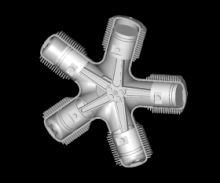

Since the axes of the cylinders are coplanar, theconnecting rodscannot all be directly attached to thecrankshaftunless mechanically complex forked connecting rods are used, none of which have been successful. Instead, thepistonsare connected to the crankshaft with a master-and-articulating-rod assembly. One piston, the uppermost one in the animation, has a master rod with a direct attachment to the crankshaft. The remaining pistons pin theirconnecting rods' attachments to rings around the edge of the master rod. Extra "rows" of radial cylinders can be added in order to increase the capacity of the engine without adding to its diameter.
Four-strokeradials have an odd number of cylinders per row, so that a consistent every-other-pistonfiring ordercan be maintained, providing smooth operation. For example, on a five-cylinder engine the firing order is 1, 3, 5, 2, 4, and back to cylinder 1. Moreover, this always leaves a one-piston gap between the piston on its combustion stroke and the piston on compression. The active stroke directly helps compress the next cylinder to fire, making the motion more uniform. If an even number of cylinders were used, an equally timed firing cycle would not be feasible.
As with most four-strokes, the crankshaft takes two revolutions to complete the four strokes of each piston (intake, compression, combustion, exhaust). The camshaft ring is geared to spin slower and in the opposite direction to the crankshaft. Its cam lobes are placed in two rows; one for the intake valves and one for the exhaust valves. The radial engine normally uses fewer cam lobes than other types. For example, in the engine in the animated illustration, four cam lobes serve all 10 valves across the five cylinders, whereas 10 would be required for a typical inline engine with the same number of cylinders and valves.
Most radial engines use overheadpoppet valvesdriven bypushrodsandlifterson a cam plate which is concentric with the crankshaft, with a few smaller radials, like theKinner B-5and RussianShvetsov M-11,using individual camshafts within the crankcase for each cylinder. A few engines usesleeve valvessuch as the 14-cylinderBristol Herculesand the 18-cylinderBristol Centaurus,which are quieter and smoother running but require much tightermanufacturing tolerances.[citation needed]
History[edit]
Aircraft[edit]
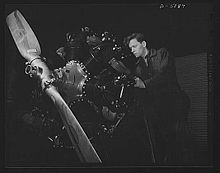

C. M. Manlyconstructed a water-cooled five-cylinder radial engine in 1901, a conversion of one ofStephen Balzer'srotary engines,forLangley'sAerodromeaircraft.Manly's engineproduced 52 hp (39 kW) at 950 rpm.[1]
In 1903–1904Jacob Ellehammerused his experience constructing motorcycles to build the world's first air-cooled radial engine, a three-cylinder engine which he used as the basis for a more powerful five-cylinder model in 1907. This was installed in histriplaneand made a number of short free-flight hops.[2]
Another early radial engine was the three-cylinderAnzani,originally built as a W3 "fan" configuration, one of which poweredLouis Blériot'sBlériot XIacross theEnglish Channel.Before 1914, Alessandro Anzani had developed radial engines ranging from 3 cylinders (spaced 120° apart) — early enough to have been used on a few French-built examples of the famousBlériot XIfrom the original Blériot factory — to a massive 20-cylinder engine of 200 hp (150 kW), with its cylinders arranged in four rows of five cylinders apiece.[1]
Most radial engines areair-cooled,but one of the most successful of the early radial engines (and the earliest "stationary" design produced for World War I combat aircraft) was theSalmson 9Z series of nine-cylinder water-cooled radial enginesthat were produced in large numbers. Georges Canton and Pierre Unné patented the original engine design in 1909, offering it to theSalmsoncompany; the engine was often known as the Canton-Unné.[3]
From 1909 to 1919 the radial engine was overshadowed by its close relative, therotary engine,which differed from the so-called "stationary" radial in that the crankcase and cylinders revolved with the propeller. It was similar in concept to the later radial, the main difference being that the propeller was bolted to the engine, and the crankshaft to the airframe. The problem of the cooling of the cylinders, a major factor with the early "stationary" radials, was alleviated by the engine generating its own cooling airflow.[4]
InWorld War Imany French and other Allied aircraft flew withGnome,Le Rhône,Clerget,andBentleyrotary engines, the ultimate examples of which reached 250 hp (190 kW) although none of those over 160 hp (120 kW) were successful. By 1917 rotary engine development was lagging behind new inline and V-type engines, which by 1918 were producing as much as 400 hp (300 kW), and were powering almost all of the new French and British combat aircraft.
Most German aircraft of the time used water-cooled inline 6-cylinder engines.Motorenfabrik Oberurselmade licensed copies of the Gnome and Le Rhône rotary powerplants, andSiemens-Halskebuilt their own designs, including theSiemens-Halske Sh.III eleven-cylinder rotary engine,which was unusual for the period in being geared through abevel geartrainin the rear end of the crankcasewithoutthe crankshaft being firmly mounted to the aircraft's airframe, so that the engine's internal working components (fully internal crankshaft "floating" in its crankcase bearings, with its conrods and pistons) were spun in the opposing direction to the crankcase and cylinders, which still rotated as the propeller itself did since it was still firmly fastened to the crankcase's frontside, as with regularumlaufmotorGerman rotaries.
By the end of the war the rotary engine had reached the limits of the design, particularly in regard to the amount of fuel and air that could be drawn into the cylinders through the hollow crankshaft, while advances in bothmetallurgyand cylinder cooling finally allowed stationary radial engines to supersede rotary engines. In the early 1920s Le Rhône converted a number of their rotary engines into stationary radial engines.
By 1918 the potential advantages of air-cooled radials over the water-cooledinline engineand air-cooledrotary enginethat had powered World War I aircraft were appreciated but were unrealized. British designers had produced theABC Dragonflyradial in 1917, but were unable to resolve the cooling problems, and it was not until the 1920s thatBristolandArmstrong Siddeleyproduced reliable air-cooled radials such as theBristol Jupiter[5]and theArmstrong Siddeley Jaguar.[citation needed]
In the United States theNational Advisory Committee for Aeronautics(NACA) noted in 1920 that air-cooled radials could offer an increase inpower-to-weight ratioand reliability; by 1921 the U.S. Navy had announced it would only order aircraft fitted with air-cooled radials and other naval air arms followed suit.Charles Lawrance'sJ-1 enginewas developed in 1922 with Navy funding, and using aluminum cylinders with steel liners ran for an unprecedented 300 hours, at a time when 50 hours endurance was normal. At the urging of the Army and Navy theWright Aeronautical Corporationbought Lawrance's company, and subsequent engines were built under the Wright name. The radial engines gave confidence to Navy pilots performing long-range overwater flights.[6]
Wright's 225 hp (168 kW)J-5 Whirlwindradial engine of 1925 was widely claimed as "the first truly reliable aircraft engine".[7]Wright employedGiuseppe Mario Bellancato design an aircraft to showcase it, and the result was theWright-Bellanca WB-1,which first flew later that year. The J-5 was used on many advanced aircraft of the day, includingCharles Lindbergh'sSpirit of St. Louis,in which he made the first solo trans-Atlantic flight.[8]
In 1925 the AmericanPratt & Whitneycompany was founded, competing with Wright's radial engines. Pratt & Whitney's initial offering, theR-1340 Wasp,was test run later that year, beginning a line of engines over the next 25 years that included the 14-cylinder, twin-rowPratt & Whitney R-1830 Twin Wasp.More Twin Wasps were produced than any other aviation piston engine in the history of aviation; nearly 175,000 were built.[9]
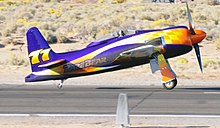
In the United Kingdom theBristol Aeroplane Companywas concentrating on developing radials such as the Jupiter,Mercury,andsleeve valveHerculesradials. Germany, Japan, and the Soviet Union started with building licensed versions of the Armstrong Siddeley, Bristol, Wright, or Pratt & Whitney radials before producing their own improved versions.[citation needed]France continued its development of various rotary engines but also produced engines derived from Bristol designs, especially the Jupiter.
Although other piston configurations andturbopropshave taken over in modernpropeller-driven aircraft,Rare Bear,which is aGrumman F8F Bearcatequipped with aWright R-3350 Duplex-Cycloneradial engine, is stillthe fastest piston-powered aircraft.[10][11]
125,334 of the American twin-row, 18-cylinderPratt & Whitney R-2800 Double Wasp,with a displacement of 2,800 in3(46 L) and between 2,000 and 2,400 hp (1,500-1,800 kW), powered the American single-engineVought F4U Corsair,Grumman F6F Hellcat,Republic P-47 Thunderbolt,twin-engineMartin B-26 Marauder,Douglas A-26 Invader,Northrop P-61 Black Widow,etc. The same firm's aforementioned smaller-displacement (at 30 litres),Twin Wasp14-cylinder twin-row radial was used as the main engine design for theB-24 Liberator,PBY Catalina,andDouglas C-47,each design being amongthe production leadersin all-time production numbers for each type of airframe design.
The AmericanWright Cyclone seriestwin-row radials powered American warplanes: the nearly-43 litre displacement, 14-cylinderTwin Cyclonepowered the single-engineGrumman TBF Avenger,twin-engineNorth American B-25 Mitchell,and some versions of theDouglas A-20 Havoc,with the massive twin-row, nearly 55-litre displacement, 18-cylinderDuplex-Cyclonepowering the four-engineBoeing B-29 Superfortressand others.
The SovietShvetsovOKB-19design bureauwas the sole source of design for all of the Soviet government factory-produced radial engines used in its World War II aircraft, starting with theShvetsov M-25(itself based on the AmericanWrightCyclone 9's design) and going on to design the 41-litre displacementShvetsov ASh-82fourteen cylinder radial for fighters, and the massive, 58-litre displacementShvetsov ASh-73eighteen-cylinder radial in 1946 - the smallest-displacement radial design from the Shvetsov OKB during the war was the indigenously designed, 8.6 litre displacementShvetsov M-11five cylinder radial.
Over 28,000 of the German 42-litre displacement, 14-cylinder, two-rowBMW 801,with between 1,560 and 2,000 PS (1,540-1,970 hp, or 1,150-1,470 kW), powered the German single-seat, single-engineFocke-Wulf Fw 190Würger,and twin-engineJunkers Ju 88.
In Japan, most airplanes were powered by air-cooled radial engines like the 14-cylinderMitsubishi Zuisei(11,903 units, e.g.Kawasaki Ki-45),Mitsubishi Kinsei(12,228 units, e.g.Aichi D3A),Mitsubishi Kasei(16,486 units, e.g.Kawanishi H8K),Nakajima Sakae(30,233 units, e.g.Mitsubishi A6MandNakajima Ki-43), and 18-cylinderNakajima Homare(9,089 units, e.g.Nakajima Ki-84). TheKawasaki Ki-61andYokosuka D4Ywere rare examples of Japanese liquid-cooled inline engine aircraft at that time but later, they were also redesigned to fit radial engines as theKawasaki Ki-100andYokosuka D4Y3.
In Britain, Bristol produced bothsleeve valvedand conventionalpoppet valvedradials: of the sleeve valved designs, more than 57,400 Hercules engines powered theVickers Wellington,Short Stirling,Handley Page Halifax,and some versions of theAvro Lancaster,over 8,000 of the pioneering sleeve-valvedBristol Perseuswere used in various types, and more than 2,500 of the largest-displacement production British radial from the Bristol firm to use sleeve valving, theBristol Centauruswere used to power theHawker Tempest IIandSea Fury.The same firm's poppet-valved radials included: around 32,000 ofBristol Pegasusused in theShort Sunderland,Handley Page Hampden,andFairey Swordfishand over 20,000 examples of the firm's 1925-origin nine-cylinder Mercury were used to power theWestland Lysander,Bristol Blenheim,andBlackburn Skua.
Tanks[edit]
In the years leading up to World War II, as the need for armored vehicles was realized, designers were faced with the problem of how to power the vehicles, and turned to using aircraft engines, among them radial types. The radial aircraft engines provided greater power-to-weight ratios and were more reliable than conventional inline vehicle engines available at the time. This reliance had a downside though: if the engines were mounted vertically, as in theM3 LeeandM4 Sherman,their comparatively large diameter gave the tank a higher silhouette than designs using inline engines.[citation needed]
TheContinental R-670,a 7-cylinder radial aero engine which first flew in 1931, became a widely used tank powerplant, being installed in theM1 Combat Car,M2 Light Tank,M3 Stuart,M3 Lee,andLVT-2 Water Buffalo.[citation needed]
TheGuiberson T-1020,a 9-cylinder radial diesel aero engine, was used in theM1A1E1,while theContinental R975saw service in theM4 Sherman,M7 Priest,M18 Hellcattank destroyer,and theM44 self propelled howitzer.[citation needed]
Modern radials[edit]

A number of companies continue to build radials today.Vedeneyevproduces the M-14P radial of 360–450 hp (270–340 kW) as used onYakovlevandSukhoiaerobatic aircraft. The M-14P is also used by builders ofhomebuilt aircraft,such as theCulp Special,andCulp Sopwith Pup,[12]PittsS12 "Monster" and theMurphy "Moose".110 hp (82 kW)7-cylinder and150 hp (110 kW)9-cylinder engines are available from Australia'sRotec Aerosport.HCI Aviation[13]offers the R180 5-cylinder (75 hp (56 kW)) and R220 7-cylinder (110 hp (82 kW)), available "ready to fly" and as a build-it-yourself kit.Verner Motorof the Czech Republic builds several radial engines ranging in power from 25 to 150 hp (19 to 112 kW).[14]Miniature radial engines formodel airplanesare available fromO. S. Engines,Saito Seisakusho of Japan, and Shijiazhuang of China, and Evolution (designed by Wolfgang Seidel of Germany, and made in India) and Technopower in the US.[citation needed]
Comparison with inline engines[edit]
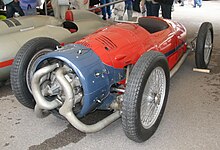
Liquid cooling systems are generally more vulnerable to battle damage. Even minor shrapnel damage can easily result in a loss of coolant and consequent engine overheating, while an air-cooled radial engine may be largely unaffected by minor damage.[16]Radials have shorter and stiffer crankshafts, a single-bank radial engine needing only two crankshaft bearings as opposed to the seven required for a liquid-cooled, six-cylinder, inline engine of similar stiffness.[17]
While a single-bank radial permits all cylinders to be cooled equally, the same is not true for multi-row engines where the rear cylinders can be affected by the heat coming off the front row, and air flow being masked.[18]
A potential disadvantage of radial engines is that having the cylinders exposed to the airflow increasesdragconsiderably. The answer was the addition of specially designed cowlings with baffles to force the air between the cylinders. The first effective drag-reducing cowling that didn't impair engine cooling was the BritishTownend ringor "drag ring" which formed a narrow band around the engine covering the cylinder heads, reducing drag. TheNational Advisory Committee for Aeronauticsstudied the problem, developing theNACA cowlingwhich further reduced drag and improved cooling. Nearly all aircraft radial engines since have used NACA-type cowlings.[Note 1]
While inline liquid-cooled engines continued to be common in new designs until late inWorld War II,radial engines dominated afterwards until overtaken by jet engines, with the late-warHawker Sea FuryandGrumman F8F Bearcat,two of the fastest production piston-engined aircraft ever built, using radial engines.
Hydrolock[edit]
Whenever a radial engine remains shut down for more than a few minutes, oil or fuel may drain into the combustion chambers of the lower cylinders or accumulate in the lower intake pipes, ready to be drawn into the cylinders when the engine starts. As the piston approachestop dead center(TDC) of the compression stroke, this liquid, being incompressible, stops piston movement. Starting or attempting to start the engine in such condition may result in a bent or broken connecting rod.[21]
Other types of radial engine[edit]
Multi-row radials[edit]
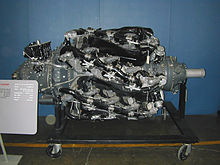
Originally radial engines had one row of cylinders, but as engine sizes increased it became necessary to add extra rows. The first radial-configuration engine known to use a twin-row design was the 160 hp Gnôme "Double Lambda" rotary engine of 1912, designed as a 14-cylinder twin-row version of the firm's 80 hpLambdasingle-row seven-cylinder rotary, however reliability and cooling problems limited its success.
Two-row designs began to appear in large numbers during the 1930s, when aircraft size and weight grew to the point where single-row engines of the required power were simply too large to be practical. Two-row designs often had cooling problems with the rear bank of cylinders, but a variety of baffles and fins were introduced that largely eliminated these problems. The downside was a relatively large frontal area that had to be left open to provide enough airflow, which increased drag. This led to significant arguments in the industry in the late 1930s about the possibility of using radials for high-speed aircraft like modern fighters.[citation needed]
The solution was introduced with the BMW 801 14-cylinder twin-row radial.Kurt Tankdesigned a new cooling system for this engine that used a high-speed fan to blow compressed air into channels that carry air to the middle of the banks, where a series of baffles directed the air over all of the cylinders. This allowed the cowling to be tightly fitted around the engine, reducing drag, while still providing (after a number of experiments and modifications) enough cooling air to the rear. This basic concept was soon copied by many other manufacturers, and many late-WWII aircraft returned to the radial design as newer and much larger designs began to be introduced.[citation needed]Examples include theBristol Centaurusin theHawker Sea Fury,and theShvetsov ASh-82in theLavochkin La-7.[citation needed]
For even greater power, adding further rows was not considered viable due to the difficulty of providing the required airflow to the rear banks. Larger engines were designed, mostly using water cooling although this greatly increased complexity and eliminated some of the advantages of the radial air-cooled design. One example of this concept is theBMW 803,which never entered service.[citation needed]
A major study[which?]into the airflow around radials usingwind tunnelsand other systems was carried out in the US, and demonstrated that ample airflow was available with careful design. This led to theR-4360,which has 28 cylinders arranged in a 4 rowcorncobconfiguration. The R-4360 saw service on large American aircraft in the post-World War IIperiod. The US andSoviet Unioncontinued experiments with larger radials, but the UK abandoned such designs in favour of newer versions of the Centaurus and rapid movement to the use ofturbopropssuch as theArmstrong Siddeley PythonandBristol Proteus,which easily produced more power than radials without the weight or complexity.[citation needed]
Large radials continued to be built for other uses, although they are no longer common. An example is the 5-tonZvezda M503diesel engine with 42 cylinders in 6 rows of 7, displacing 143.6 litres (8,760 cu in) and producing 3,942 hp (2,940 kW). Three of these were used on the fastOsa class missile boats.[citation needed]Another one was theLycoming XR-7755which was the largest piston aircraft engine ever built in the United States with 36 cylinders totaling about 7,750 in3(127 L) of displacement and a power output of 5,000 horsepower (3,700 kilowatts).
Diesel radials[edit]


While most radial engines have been produced for gasoline, there have been diesel radial engines. Two major advantages favourdiesel engines— lower fuel consumption and reduced fire risk.[citation needed]
- Packard
Packard designed and built a 9-cylinder 980 cubic inch (16.06 litre) displacement diesel radial aircraft engine, the 225 horsepower (168 kW)DR-980,in 1928. On 28 May 1931, a DR-980 poweredBellanca CH-300,with 481 gallons of fuel, piloted byWalter Edwin LeesandFrederick Brossyset a record for staying aloft for 84 hours and 32 minutes without being refueled.[22]This record stood for 55 years until broken by theRutan Voyager.[23]
- Bristol
The experimentalBristol Phoenixof 1928–1932 was successfully flight tested in aWestland Wapitiand set altitude records in 1934 that lasted until World War II.[citation needed]
- Clerget
In 1932 the French company Clerget developed the 14D, a 14-cylindertwo-stroke dieselradial engine. After a series of improvements, in 1938 the 14F2 model produced 520 hp (390 kW) at 1910 rpm cruise power, with a power-to-weight ratio near that of contemporary gasoline engines and aspecific fuel consumptionof roughly 80% that for an equivalent gasoline engine. During WWII the research continued, but no mass-production occurred because of the Nazi occupation. By 1943 the engine had grown to produce over 1,000 hp (750 kW) with aturbocharger.After the war, the Clerget company was integrated in theSNECMAcompany and had plans for a 32-cylinder diesel engine of 4,000 hp (3,000 kW), but in 1947 the company abandoned piston engine development in favour of the emerging turbine engines.[citation needed]
- Nordberg
TheNordberg Manufacturing Companyof the United States developed and produced a series of largetwo-strokeradial diesel engines from the late 1940s for electrical production, primarily ataluminumsmelters and for pumping water. They differed from most radials in that they had an even number of cylinders in a single bank (or row) and an unusual double master connecting rod. Variants were built that could be run on either diesel oil or gasoline or mixtures of both. A number of powerhouse installations utilising large numbers of these engines were made in the U.S.[24]
- EMD
Electro-Motive Diesel(EMD) built the "pancake" engines 16-184 and 16-338 for marine use.[25]
- Zoche
Zoche aero-dieselsare a prototype radial design that have an even number of cylinders, either four or eight; but this is not problematic, because they aretwo-stroke engines,with twice the number of power strokes as a four-stroke engine per crankshaft rotation.[26][third-party source needed]
Compressed air radial engines[edit]
A number of radial motors operating on compressed air have been designed, mostly for use in model airplanes and in gas compressors.[27]
Model radial engines[edit]
A number of multi-cylinder 4-strokemodel engineshave been commercially available in a radial configuration, beginning with the JapaneseO.S. Maxfirm's FR5-300 five-cylinder, 3.0 cu.in. (50 cm3) displacement "Sirius" radial in 1986. The American "Technopower" firm had made smaller-displacement five- and seven-cylinder model radial engines as early as 1976, but the OS firm's engine was the first mass-produced radial engine design inaeromodellinghistory. The rival Saito Seisakusho firm in Japan has since produced a similarly sized five-cylinder radial four-stroke model engine of their own as a direct rival to the OS design, with Saito also creating a series of three-cylinder methanol and gasoline-fueled model radial engines ranging from 0.90 cu.in. (15 cm3) to 4.50 cu.in. (75 cm3) in displacement, also all now available in spark-ignition format up to 84 cm3displacement for use with gasoline.[28]The German Seidel firm formerly made both seven- and nine-cylinder "large" (starting at 35 cm3displacement) radio control model radial engines, mostly for glow plug ignition, with an experimental fourteen-cylinder twin-row radial being tried out - the American Evolution firm now sells the Seidel-designed radials, with their manufacturing being done in India.[citation needed]
See also[edit]
Notes[edit]
- ^It has been claimed that the NACA cowling generated extra thrust due to theMeredith Effect,whereby the heat added to the air being forced through the ducts between the cylinders expanded the exhausting cooling air, producing thrust when forced through a nozzle. The Meredith effect requires high airspeed and careful design to generate a suitable high speed exhaust of the heated air – the NACA cowling was not designed to achieve this, nor would the effect have been significant at low airspeeds.[19]The effectwasput to use in the radiators of several mid-1940s aircraft that used liquid-cooled engines such as theSpitfireandMustang,[20]and it offered a minor improvement in later radial-engined aircraft, including theFw 190.
References[edit]
- ^abVivian, E. Charles (1920).A History of Aeronautics.Dayton History Books Online. Archived fromthe originalon 2009-05-23.Retrieved2008-07-05.
- ^Day, Lance; Ian McNeil (1996).Biographical Dictionary of the History of Technology.Taylor & Francis. p.239.ISBN0-415-06042-7.
- ^Lumsden 2003, p. 225.
- ^Nahum, Andrew (1999).The Rotary Aero Engine.NMSI Trading Ltd.ISBN1-900747-12-X.
- ^Gunston, Bill (1989).World Encyclopedia of Aero Engines.Cambridge, UK: Patrick Stephens Ltd. pp. 29, 31 & 44.ISBN1-85260-163-9.
- ^Bilstein, Roger E. (2008).Flight Patterns: Trends of Aeronautical Development in the United States, 1918–1929.University of Georgia Press. p. 26.ISBN978-0-8203-3214-7.
- ^Herrmann, Dorothy (1993).Anne Morrow Lindbergh: A Gift for Life.Ticknor & Fields. p.28.ISBN0-395-56114-0.
- ^"The Spirit of St. Louis".Charles Lindergh: An American Aviator, Retrieved 21 August 2015.
- ^- Archived (Nov. 11, 2013) manufacturer's product page, R-1830Retrieved: 7 February 2019
- ^Lewis Vintage Collection (2018),"'Rare Bear' web site."Archived2013-10-27 at theWayback Machine.Retrieved: 6 January 2018.
- ^Aerospaceweb,"Aircraft speed records."AeroSpaceWeb.org.Retrieved: 6 January 2018.
- ^"Aircraft".Culp Specialties.Retrieved2013-12-22.
- ^"HCI (USA)".Aerospace Engines A to Z.Retrieved2023-02-11.
- ^"Verner Motor range of engines".Verner Motor.Archived fromthe originalon 6 October 2014.Retrieved23 April2013.
- ^"MONACO - TROSSI mod. da competizione".museoauto.it.Retrieved10 November2016.
- ^Thurston, David B.(2000).The World's Most Significant and Magnificent Aircraft: Evolution of the Modern Airplane.SAE. p. 155.ISBN0-7680-0537-X.
- ^Some six-cylinder inline engines used as few as three bearings, but at the cost of heavier crankshafts, or crankshaft whipping.
- ^Fedden, A.H.R.(28 February 1929)."Air-cooled Engines in Service".Flight.XXI(9): 169–173.
- ^Becker, J.;The high-speed frontier: Case histories of four NACA programs, 1920- SP-445, NASA (1980), Chapter 5: High-speed Cowlings, Air Inlets and Outlets, and Internal-Flow Systems: The ramjet investigation
- ^Price 1977, p. 24.
- ^Powerplant Maintenance for Reciprocating Engines.Department of the Air Force.1953. pp. 53–54.
- ^Chapter 1: Development of the Diesel Aircraft Engine "Archived2012-02-12 at theWayback MachineAircraft Engine Historical Society — Diesels p.4 Retrieved: 30 January 2009.
- ^Aviation ChronologyRetrieved: 7 February 2009.
- ^"Nordberg Diesel Engines".OldEngine. Archived fromthe originalon 2018-09-19.Retrieved2006-11-20.
- ^Pearce, William (18 August 2014)."General Motors / Electro-Motive 16-184 Diesel Engine".oldmachinepress.Retrieved30 May2016.
- ^"zoche aero-diesels homepage".zoche.de.Retrieved30 May2016.
- ^"Bock radial piston compressor".Bock.de. 2009-10-19. Archived fromthe originalon 2011-10-08.Retrieved2011-12-06.
- ^Saito Seisakusho Worldwide E-book catalog, pages 9, 17 & 18
